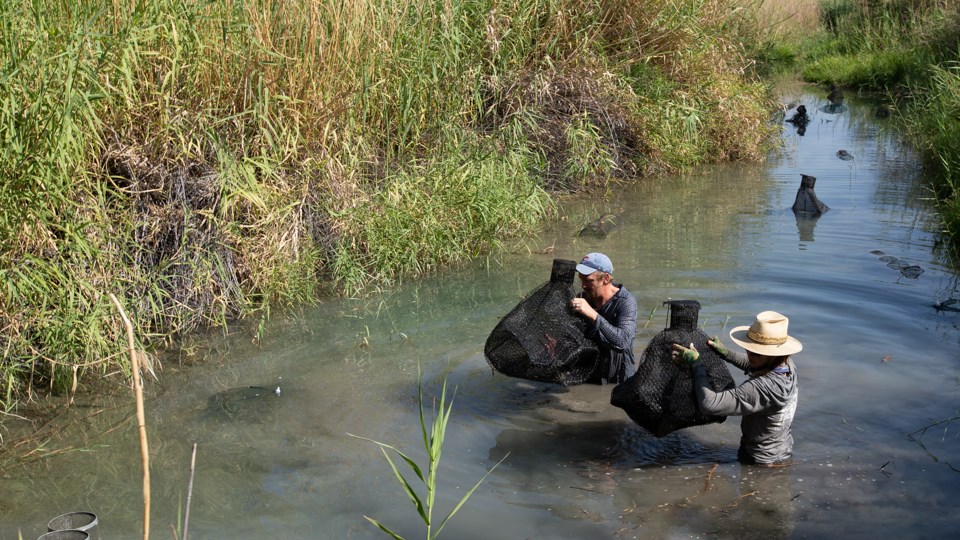
NPS/CA Hoyt 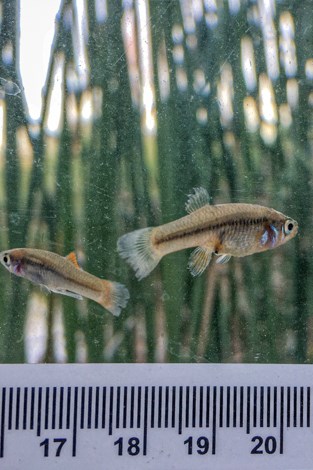
NPS/CA Hoyt Hanging In There Since its discovery, the Big Bend gambusia has come within a fin’s breadth of extinction several times. At one point, only three fish existed—Adam, Eve, and Steve as they are fondly known. But these three fish produced numerous offspring that managed to survive and reproduce. Today, an estimated 20,000 descendants swim in pools near Rio Grande Village. They’re finicky little fish. They prefer water that’s a constant 92 to 95°F and swim among dense stands of Chara (a type of green algae that has stem-like and leaf-like structures). As far as we know, their entire wild population exists in only three ponds in a quarter-mile circle within Big Bend National Park (and a captive “safety” broodstock managed at the Southwestern Native Aquatic Resource and Recovery Center near Dexter, New Mexico). 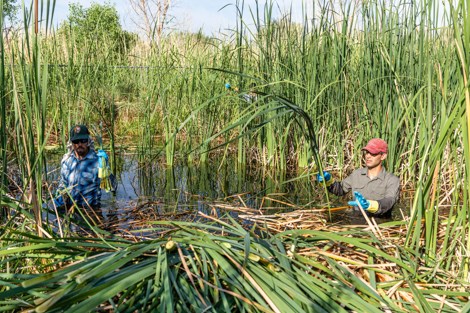
NPS/CA Hoyt Rare already, the Big Bend gambusia must cope with constant threats to their existence. A sudden cold snap will kill them. A decrease in spring flows could wipe them out. Invasive species outcompete or flat-out eat the Big Bend gambusia. While National Park Service staff can’t control the climate and have minimal influence on spring flow, they can do something about the invasive species. 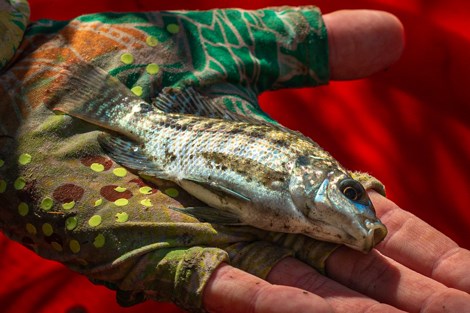
NPS/CA Hoyt Dr. Sean Graham, a biology professor at Sul Ross State University, is the guardian of the gambusia today. He monitors the population and removes invasive species that may compete with the minnow. Graham pulls into the gravel road leading to the gambusia ponds in a pickup truck dented from fieldwork and a severe hailstorm. He gestures toward a reed-lined pool of shallow water. “These ponds are the last refuge for gaigei,” he said. “But they’re a refuge for invasives, too.” He ticks off an impressive list: “Blue tilapia, western mosquitofish, red shiners, red-eared sliders, bullfrogs, green tree frogs, anoles…many of these introduced species compete with the Big Bend gambusia for scarce resources.” “The western mosquitofish is the most serious threat,” he says. “They’re aggressive and prolific.” The western mosquitofish were introduced many years ago when it was the thing to do. Got open water? Throw some mosquitofish in as a biological control of mosquito larvae. Unfortunately, western mosquitofish don’t eat that many mosquito larvae. Instead, they prey on zooplankton, beetles, mayflies caddisflies, and mites—many of which do feed on mosquito larvae. The only place the western mosquitofish can’t outcompete the Big Bend gambusia is in the pond’s warmest sections. 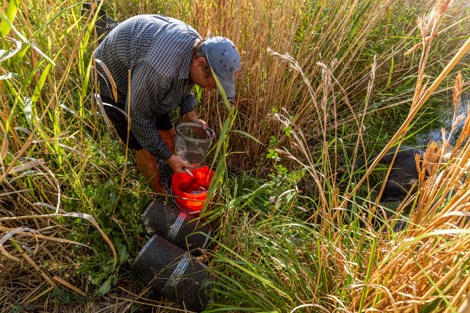
NPS/CA Hoyt Graham and Wogan gingerly enter the pond, pushing overhanging reeds from their faces. They immediately sink to their knees in mud. Both groan. In slow motion, they move towards the traps. Step and sink. Pull and step. Dozens of western mosquitofish, blue tilapia (both adults and fry), and a giant bullfrog fill the traps. “I’ve got a turtle!” Wogan yells. She drags her trap back to Graham and pulls out a young, palm-sized turtle. The carapace has the bright pattern of a red-eared slider. Graham gently pulls out the turtle’s head to look for the distinctive red-ear of the invasive turtle. Instead, the turtle sports a red oval—the unique mark of the native Big Bend slider. Maybe a hybrid? Puzzled, Graham drops the turtle into the “think about it later” bucket. Two hours pass. All the traps are collected, emptied, folded, and returned to the truck bed. Graham and Wogen removed hundreds of invasives from the ponds. Hundreds is a good start, but thousands remain. Graham will be back. Every week through the summer, he’ll set his traps and slog through the mud to retrieve them and their unwanted cargo. “I’m a herpetologist, and most of my work has focused on reptile conservation,” says Graham. “But it’s hard. Reptiles aren’t the most charismatic of animals.” He smiles—a herpetologist that can’t understand the general public’s phobia of snakes and lizards. “But here, with these fish, I think I can make a difference.”
[1] Hubbs, C.L. 1929. Studies of the fishes of the order Cyprinodontes VIII. Gambusia gaigei, a new species from the Rio Grande. Occasional Papers of the Museum of Zoology University of Michigan, 198, 11 pp. [2] Quote from Episode 180 of Nature Notes on Marfa Public Radio. Broadcast 5.26.2011. Ranger C.A. Hoyt 2020DEC21 |
Last updated: July 18, 2025
